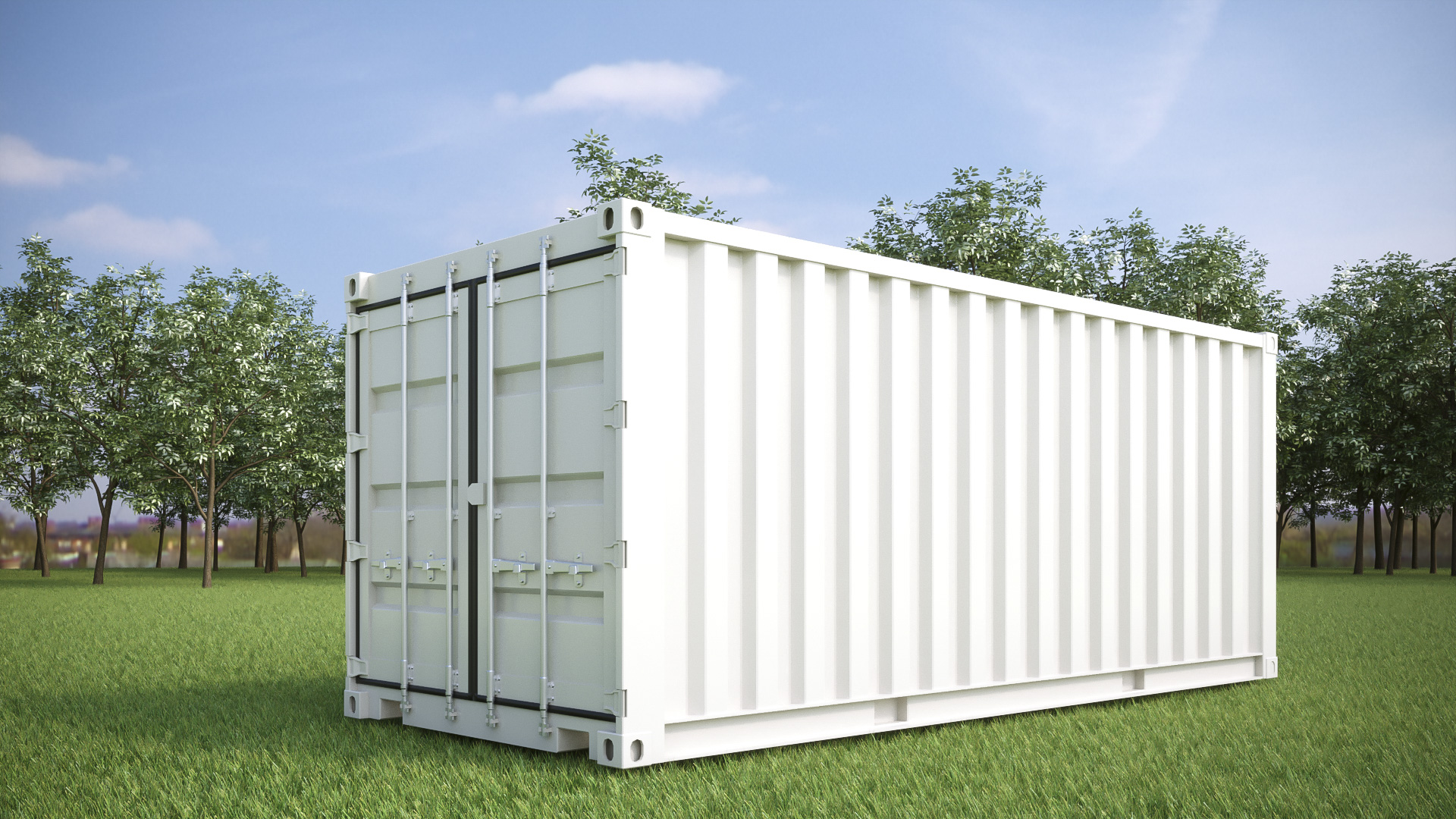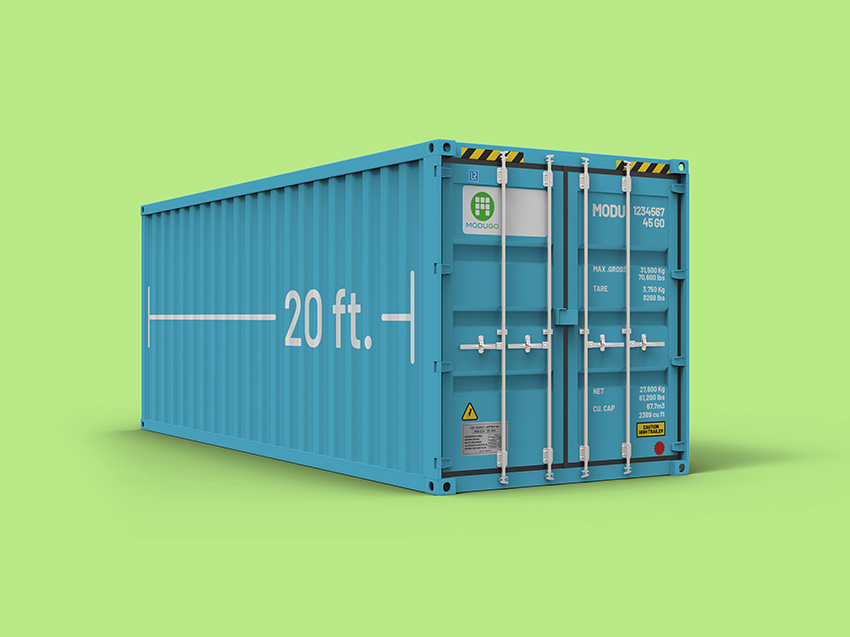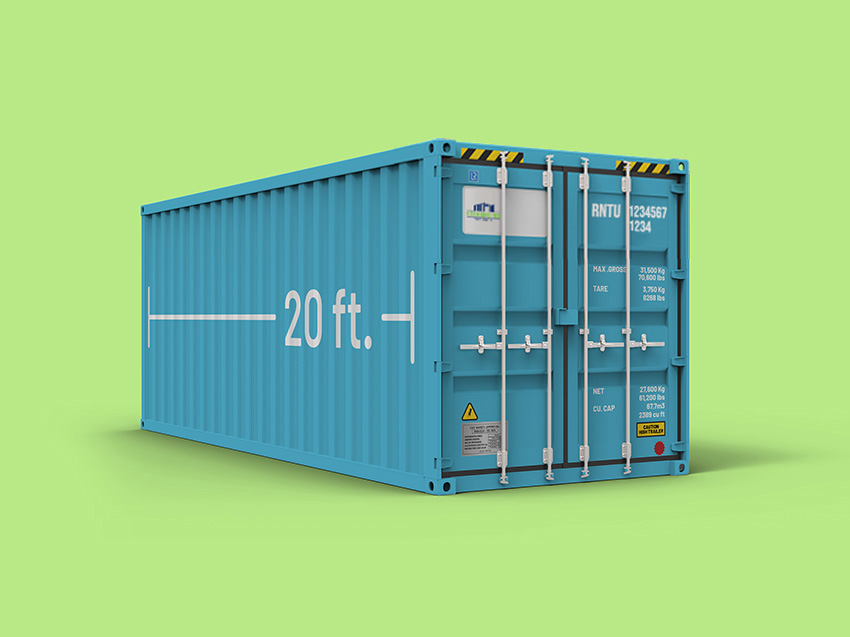eehether you need ample space for personal items, quick-access storage on a construction site, or temporary space to manage a project, a 20 foot shipping container may be the perfect choice.
Read on to learn all about 20 foot shipping containers but click here if you're looking for 40 foot shipping containers.
Looking to buy or rent a container and get instant, affordable pricing? Get an instant quote >
Benefits and Common Uses of 20 ft Steel Shipping Containers
- A medium sized container fits in most vacant locations while still a substantial size
- 20 foot steel shipping containers are a great way to store or move personal items
- Ground level containers makes it easy to climb in-and-out safely
- Safely lock up construction tools, materials, and vehicles to keep them secure
- Keep your materials out of the weather elements
- Portable and relocatable, medium sized shipping containers can adapt to your site
- This shipping container size is relatively affordable, and you have several purchasing options
- Popular with the retail, restaurant, and Construction Industries
- New home building movement
*Not all container sizes and conditions are available for rent, please check our inventory or contact us to inquire about any options you do not see on our online store.
What fits in a 20 Foot Shipping Container?
A 20’ metal shipping container is one of the most common sized cargo containers. The other most common size is 40 ft. long. So just how large is a 20 foot shipping container? Industry standards suggest that a one or two bedroom apartment or 1 standard passenger vehicle can typically fit in a 20 ft. shipping container. But to give you the precise dimensions of a 20 foot container, check out the tables below:

20 ft. Shipping Container Dimensions
| Exterior Dimensions of 20 ft. Containers | ||||||
|---|---|---|---|---|---|---|
| Type of Container | Height | Height (Metric) |
Width | Width (Metric) |
Length | Length (Metric) |
| Exterior Dimensions of 20 ft. Containers | ||||||
| Standard 20 foot Shipping Container |
Height
8ft. 6in.
|
Height (Metric)
2.59m
|
Width
8ft.
|
Width (Metric)
2.44m
|
Length
20 ft.
|
Length (Metric)
6.06 m
|
| High Cube 20 ft. Shipping Container |
Height
9ft. 6in.
|
Height (Metric)
2.89m
|
Width
8ft.
|
Width (Metric)
2.44m
|
Length
20ft.
|
Length (Metric)
6.06 m
|
| Internal 20 Foot Container Dimensions | ||||||
|---|---|---|---|---|---|---|
| Type of Container | Height | Height (Metric) |
Width | Width (Metric) |
Length | Length (Metric) |
| Internal 20 Foot Container Dimensions | ||||||
| Standard 20 foot Shipping Container |
Height
7ft. 10 in.
|
Height (Metric)
2.38m.
|
Width
7ft. 8.5in.
|
Width (Metric)
2.35m.
|
Length
19ft. 8in.
|
Length (Metric)
5.9m
|
| High Cube 20ft. Shipping Container |
Height
8ft. 9in.
|
Height (Metric)
2.69m.
|
Width
7ft. 8.5in.
|
Width (Metric)
2.35m.
|
Length
19ft. 8in.
|
Length (Metric)
5.9m
|
| Volume of 20 ft. Containers | ||||||
|---|---|---|---|---|---|---|
| Type of Container | Volume | Volume (Metric) |
||||
| Volume of 20 ft. Containers | ||||||
| Standard 20 ft. Shipping Container |
Volume
1,170 cubic ft.
|
Volume (Metric)
33.1 cubic m
|
||||
| High Cube 20 ft. Shipping Container |
Volume
1,320 cubic ft.
|
Volume (Metric)
37.4 cubic m
|
||||
| Weight of 20 ft. Containers | ||||||
|---|---|---|---|---|---|---|
| Type of Container | Tare Weight (lbs) |
Tare Weight (kg) |
Max Cargo Weight (lbs) |
Max Cargo Weight (kg) |
||
| Weight of 20 ft. Containers | ||||||
| Standard 20 ft. Shipping Container |
Tare Weight (lbs)
4,409 lbs
|
Tare Weight (kg)
2,000 kg
|
Max Cargo Weight (lbs)
67,200 lbs
|
Max Cargo Weight (kg)
30,480 kg
|
||
| High Cube 20 ft. Shipping Container |
Tare Weight (lbs)
4,629 lbs
|
Tare Weight (kg)
2,100 kg
|
Max Cargo Weight (lbs)
67,200 lbs
|
Max Cargo Weight (kg)
30,480 kg
|
||
How Much Does a 20 Foot Shipping Container Cost?
You can buy a 20 foot shipping container, or rent a 20 foot shipping container. Buying or renting are both good options to help you manage costs and find the best shipping container for your money.
20’ Shipping Containers for Rent or Sale
The sections below will help further illustrate how to determine the amount of money you’ll spend on a 20 foot shipping container.
Check out our guide to buying a shipping container for more great information to help you in the purchasing and preparation process.
Ask yourself the following questions when estimating the price:
- Will you be renting or buying your 20 foot shipping container?
- Will you be shopping for a new or used condition container?
- Will you be buying a specialty container with unique height requirements or door layouts?
- How far will the container need to ship to get to your destination?
Ask yourself the following questions when buying a 20 foot shipping container:
- Will you be renting or buying your 20 foot shipping container?
- Will you be shopping for a new or used condition container?
- Will you be buying a specialty container with unique height requirements or door layouts?
- How far will the container need to ship to get to your destination?
What Types of 20 Foot Shipping Containers can I purchase?
There are plenty of ways to buy a 20 foot shipping container. Your purchase options include one trip, cargo worthy, wind and water tight, or as is. Browse these options to find the perfect container to rent or buy.
New and Used 20 Foot Shipping Containers
You’ll find the perfect match between your shipping container budget and needs by browsing your condition options for 20 foot shipping containers. We sell new 20 foot shipping containers and used 20 foot shipping containers.

One Trip
Shopping for a NEW container means you simply get the best in quality. Your 20 foot container will show up at your home or job site in pristine condition.

Cargo Worthy
These are the highest quality USED containers that you’ll find when buying or renting units. Cargo Worthy containers have been inspected and deemed worthy of holding and protecting cargo for transport. Often contain minor imperfections such as surface rust, dings, or dents.

Wind and Water Tight
These USED containers are best equipped to handle static storage of your items. Containers have been inspected to ensure they don’t allow wind and water events to damage your belongings.

As Is
As-is 20 foot containers are best suited for customers that are unconcerned with significant defects or are handi-enough to fix them, themselves. Often the most affordable, yet customers need to be prepared for holes in the plywood flooring or inoperable doors.
20 Foot Shipping Container Height - Shop High Cube and Standard Containers
As laid out above in the dimensions tables, shipping containers come in standard and high cube heights. Standard shipping containers are 8 feet 6 inches tall. High Cube containers give customers another foot of space and stand 9 feet 6 inches tall. The added volume and weight make high cube containers cost slightly more than their standard counterparts.

20 Foot Shipping Container Door Styles
20 foot shipping containers come with a variety of door layouts. Open side containers have side doors allowing you to access your materials via the long side of the container. Double door shipping containers give you the ability to enter from either short end of the container via sets of cargo doors. Doors on both ends allow you to easily pull items in and all the way through the other side as needed.
People also Viewed
How Much Does a 20 Foot Shipping Container Hold?
To understand that, you need to know the cubic feet of a 20ft container.
The 20ft container capacity (20ft container cubic feet) is 32.6 cubic meters or 1,172 cubic feet worth of material, but likely you will want to factor in room to maneuver stored materials.
The key to using your 20 foot shipping container to its storage capacity potential is understanding how much it can actually fit inside of it. Perhaps you’re trying to load it with vehicles, construction equipment, furniture, or you’re using it as a multi-functional storage space.
You can transport 10 standard pallets in a 20-foot shipping container provided that you don’t stack the pallets. It’s not unreasonable to assume that you could transport the entire contents of a one or two-bedroom apartment in a single unit.
The trick is that furniture and other common household items often have irregular sizes and may vary drastically. Roughly speaking, beds can be measured at:
- 1.7 m³
- 0.85 m³
- 1.25 m³
- And so on
Let’s be safe and assume that you have a 1.7 cubic meter bed. That means, you could fit roughly 19 beds.
Bookcases often measure at 1.1 m³ or 1.4 m³. And the average TV is somewhere near 0.75 m³. That is 23 book cases and 43 televisions respectively.
Still, the contents of a one or two-bedroom apartment are a good estimate.
If you’re shipping for business, go with the 10-pallet rule and try to estimate your shipping needs using that baseline.
Let’s take a look at some common ways to better understand what you can fit into one of these containers.
Figure out the Internal Dimensions
If you want to figure out “how much can my 20-foot shipping container hold?”, you first need to determine the internal dimensions of the container. This will vary by a few inches from container to container depending on which company manufactured it. In general, a 20-foot shipping container’s internal dimensions will measure as follows:
- In imperial or US customary units: 19’4”L x 7’9”W x 7’10”H
- In metric units: 5.898 m L x 2.352 m W x 2.393 m H
Area: Square Feet and Meters
So how much space does that really add up to? It translates to about 32.6 m³. Put in other terms, it translates to 146 ft.² or 13.86 m² of total space you can use on the floor.
Volume of a 20 foot Shipping Container
While the above overall volume of 32.6 m³ or 1,172 cubic feet is a good rule of thumb, keep in mind that you won’t fill this full space unless you were to transport pallets or boxes that fit perfectly snug against one another.
The shipping container will probably need a little bit of wiggle room for vents, tools, mats, desiccant materials to prevent container rain (i.e. ambient water buildup over time), and room for you and any helpers to unload materials.
Your stuff, too, will take up more space than you might imagine when you factor in bubble wrap, packing materials, and irregular shapes (like most furniture).
It’s always best to plan to leave a little bit of space even if you try to pack the shipping container as tightly as you can.
How Many Cars Can a 20-Foot Shipping Container Hold?
If you’re storing or packing your shipping container with a vehicle, know that you should be able to fit most standard cars in a single 20-foot container with a little bit of space left over. We wouldn’t recommend trying to squeeze two cars into a single 20-foot container. Aside from the space issues, the two cars might also be too heavy for the container’s structural integrity.
How to Pack a 20 Foot Shipping Container
You can always maximize your space inside a 20-foot shipping container by practicing good moving or shipping rules.
Use units, such as boxes and pallets
Want to know “how many boxes fit in a 20 foot shipping container?”
It depends on the size of the boxes, but organizing in units like that will help you save space.
Same goes with the question, “how much furniture can fit in a 20 foot container?”
Always try to break down any goods or furniture you want to move before loading them into a shipping container. Placing things in boxes allows you to stack all those goods atop one another on standard or Euro pallets. And they allow you to more easily understand how much volume you have.
Standard vs Euro Pallets
Chances are that, if you use a shipping container of any size, you’ll probably place your goods, products, or moving stuff on pallets. However, there are two main types of pallets you can place in shipping containers – Standard or Euro.
The standard palette has a size regulated by the International Organization for Standardization (ISO), which many shipping companies use to keep their palette sizes standardized for easy transitioning from container to truck and so on.
Standard pallets are 1200 mm x 1000 mm while Euro pallets are 1200 mm x 800 mm. Practically, this means that you can hold 10 standard pallets or 12 Euro pallets in a 20-foot shipping container.
Which one is better depends on your needs, although most people choose standard pallets by default. Note that these values are assuming you won’t be stacking the pallets.
Have a plan before you load the container
Always try to have a plan when you load the container to save time with the loading and unloading process.
Consider the door arrangement and placement
There are plenty of great tips and tricks to loading your storage unit. We recommend either creating walking lanes (if the shipping container will be stationary) to access all of your packed items, or be sure to pack the things that you won’t need access to immediately in the back.
If you have two sets of doors, one set on each end, then place the items that you won’t be needing urgently in the center of the container.
For containers with a door on the side, there are multiple opportunities to stay organized. First, you could load your heaviest items, or large pallets of materials near the door side of the container. This will allow you to unpack these items with the help of heavy machinery. Or second, be sure to load any materials that you don’t need immediate access to on the opposite side of the door.
Some folks prefer placing all of the orderly boxes and stackable property in the back of the container and putting all of your irregularly shaped belongings in front. This can create an easier to understand mental map of your container space, but may not help you access the things you need later.
Consider the weight distribution
Keep in mind that, like any kind of shipping container, there is a max load for a 20 ft container.
If you need to move the container or are thinking about using it to ship your things, be sure not to put too much weight on one end of the container; keep things balanced if possible.
You should also use ties and other securing tools to make sure nothing moves during transit. Bubble wrap and other protective materials are key to ensure you don’t lose your stuff to damage during the trip.
Buy 20 Foot Containers
All in all, a 20-foot shipping container is a great size for small apartment storage, or a car plus some miscellaneous items. Remember the above values when calculating how many containers you need to buy or rent, and you’ll be good to go!






